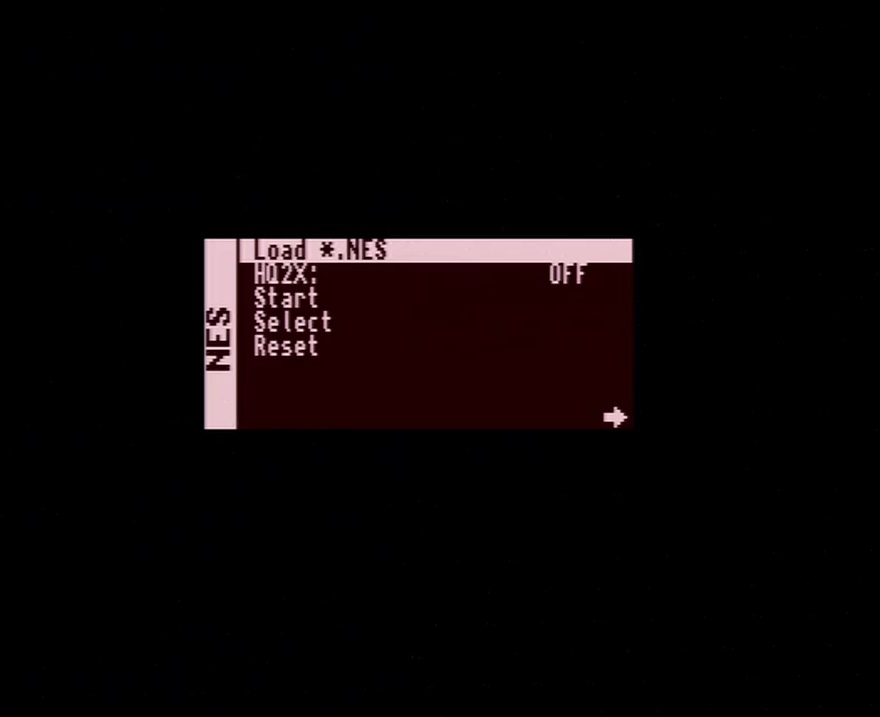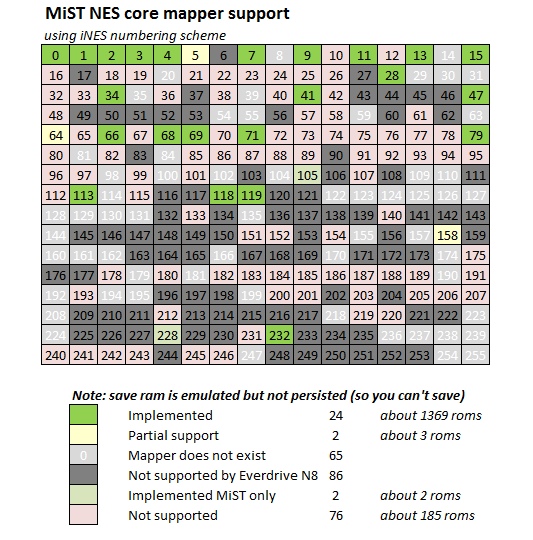-
Notifications
You must be signed in to change notification settings - Fork 83
CoreDocNES
This page has operating instructions for the NES/Famicom core.
Copy the *.rbf file at the root of the SD card.
You can rename the file to core.rbf if you want the MiST to load it automatically at startup.
Roms can be copied anywhere on the SD card and are selected via the OSD menu. If you have many files you might want to store them into alphabetized sub-folders to access them more quickly.
Controls:
- Use one or two gamepads
- Buttons 3 and 4 map to Select and Start.
- If you gamepad has only 2 buttons, you can use Select and Start from OSD menu
- F12 to open OSD
MiST front panel buttons:
- (left) Reset MiST to default core
- (middle) Open OSD menu
- (right) Reset NES with current ROM
The core will start with a blank screen. Press F12 to enter the OSD menu:

-
Load
*.NES: load a ROM from the SD card - HQ2X: active hq2x image enhancement, smoothing pixels (good for large screens)
- Start: push the Start button
- Select: push the Select button
- Reset: restart the NES core
The second page contains some general options:
- Firmware & core: allows to switch to another core or upgrade the MiST firmware
- Save settings: save the current settins to the SD card for next startup
In the rom selection screen, m can select a rom with Enter.
- Video mode is 720x481p
This table shows the memory mappers that the core supports; a large amount of commercial ROMs will run (~87%).
One major limitation is that we cannot save to the SD card.

MiST FPGA - One Chip to Rule Them All
- What is it?
- FAQ
- Board overview
- Installing firmware
- Joystick mapping
- Peripherals
- Projects it is based on
- Rom Management
- Setting up a mist.ini file
- Using a custom font
- Tested Displays/Upscalers
- Troubleshooting
- Videos
- User Videos
- Getting Started
- Current core status
- Joy/Keyboard/On-board Shortcuts
- MIDI support
- SD card setup
- Startup menu
- Acorn Archimedes
- Amstrad CPC
- Amstrad CPC - alternative
- Apogee BK-01/Radio86RK
- Apple I
- Apple II+
- Apple //e
- Apple Macintosh
- Atari 800
- Atari ST
- Atari ST/STe (mistery)
- BBC Micro
- BK0011M
- Commodore 16/Plus4
- Commodore 64
- Commodore Amiga (AGA)
- Commodore PET
- Commodore VIC-20
- Elan Enterprise
- Exidy Sorcerer
- HT1080Z (TRS80 I clone)
- LM80C
- Luxor ABC 80
- Mattel Aquarius
- Miles Gordon SAM Coupe
- MSX
- Ondra SPO 186
- Oric
- PC (Next186)
- PC (XT)
- Primo
- Sinclair QL
- Sinclair ZX80/ZX81
- Sinclair ZX Spectrum
- Sinclair ZX Spectrum 48K - alternative
- Sinclair ZX Spectrum Next
- Specialist/MX
- Tandy TRS-80 Model I
- Tandy TRS-80 Color Computer
- Texas Instruments TI-99/4A
- TSConf
- Vector-06C
- Videoton TVC
- Vtech Video Technology Laser 350/500/700
- Atari 2600
- Atari 5200
- Atari 7800
- Bally Astrocade
- Coleco ColecoVision
- GCE Vectrex
- Intellivision
- Nec PC Engine/TurboGrafx-16
- Nintendo Gameboy
- Nintendo NES
- Nintendo SNES
- Philips Videopac/Odyssey²
- Philips Videopac/Odyssey² - alternative
- Sega Genesis/Megadrive
- Sega Master System
- SNK Neo Geo MVS/AES

